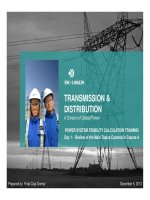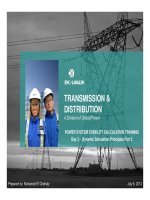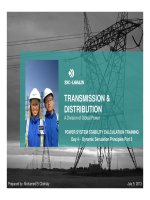Phần 7 KHÓA ĐÀO TẠO TÍNH TOÁN ỔN ĐỊNH VÀ ỨNG DỤNG TRÊN PHẦN MỀM PSSE CHO KỸ SƯ HỆ THỐNG ĐIỆN (Nguyên tắc mô phỏng Ổn định động và các thư viện mô hình mô phỏng trên Phần mềm PSSE)
Bạn đang xem bản rút gọn của tài liệu. Xem và tải ngay bản đầy đủ của tài liệu tại đây (2.88 MB, 60 trang )
TRANSMISSION &
DISTRIBUTION
A Division of Global Power
POWER SYSTEM STABILITY CALCULATION TRAINING
D3
DiSiltiPiilPt2
D
ay
3
-
D
ynam
i
c
Si
mu
l
a
ti
on
P
r
i
nc
i
p
l
es
P
ar
t
2
July 8, 2013Prepared by: Mohamed El Chehaly
eBook for You
OUTLINE
2
OUTLINE
• Classification of Variables
• Dynamic Simulation Sequence
• Overview of Simulation Procedure
eBook for You
3
CLASSIFICATION OF
VARIABLES
VARIABLES
eBook for You
General Classification
4
CLASSIFICATION OF VARIABLES
General
Classification
Constants: Parameters that do not vary
State variables: Variables for which
instantaneous values are determined by
differential equations
differential
equations
Algebraic variables: Variables for which
values can be determined if the values of all
values
can
be
determined
if
the
values
of
all
state variables, constants, and input
variables are
g
iven
g
Input variables: Quantities for which values
are s
p
ecified at an
y
instant b
y
lo
g
ic outside
pyyg
the dynamic simulation
eBook for You
5
CLASSIFICATION OF VARIABLES
Exam
p
le of Power S
y
stem D
y
namic
pyy
Simulations
eBook for You
Exam
p
le of Power S
y
stem D
y
namic
6
CLASSIFICATION OF VARIABLES
pyy
Simulations
Differential equations:
nem
n
DPP
dt
d
H
2
n
s
ync
dt
d
dt
Constants
Inertia: H
dt
Damping: D
Synchronous speed: ω
sync
= 1 p.u.
eBook for You
Exam
p
le of Power S
y
stem D
y
namic
7
CLASSIFICATION OF VARIABLES
pyy
Simulations
Sequence of Calculation:
Sequence
of
Calculation:
1. Calculate V
b
E
1
1
'
2
Calculate
I
jXRjX
jB
jXR
e
jX
E
V
b
1
'
1
/
'
'
2
.
Calculate
I
gen
'
'
jX
VE
I
b
gen
3. Calculate P
gen
jX
cos'
gengen
I
EP
eBook for You
Exam
p
le of Power S
y
stem D
y
namic
8
CLASSIFICATION OF VARIABLES
pyy
Simulations
Sequence of Calculation:
Sequence
of
Calculation:
4. Calculate time derivatives
nem
n
HDPP
dt
d
2/
n
dt
d
eBook for You
Dynamic Simulation Arrays
9
CLASSIFICATION OF VARIABLES
Dynamic
Simulation
Arrays
Constants
eBook for You
Dynamic Simulation Arrays
10
CLASSIFICATION OF VARIABLES
Dynamic
Simulation
Arrays
State Variables
Input Variables
Input
Variables
eBook for You
Dynamic Simulation Arrays
11
CLASSIFICATION OF VARIABLES
Dynamic
Simulation
Arrays
Algebraic Variables
eBook for You
Dynamic Simulation Arrays
12
CLASSIFICATION OF VARIABLES
Dynamic
Simulation
Arrays
Algebraic Variables
eBook for You
Dynamic Simulation Arrays
13
CLASSIFICATION OF VARIABLES
Dynamic
Simulation
Arrays
Internal Arrays
eBook for You
Data Space Allocation
14
CLASSIFICATION OF VARIABLES
Data
Space
Allocation
CON, VAR, STATE, ICON and DSTATE are
allocated to equipment models on a first-
come, first-served basis.
PELEC (I)PMECH (I) STATE (L)
DSTATE (L)
nem
n
HDPP
dt
d
2/
DSTATE (L+1)
n
dt
d
CON
(
J
)
CON (J+1)
()
eBook for You
Data Space Allocation
15
CLASSIFICATION OF VARIABLES
Data
Space
Allocation
Th PSS®E di f th l t l
Th
e
PSS®E
co
di
ng
f
or
th
e
l
as
t
examp
l
e:
DSTATE(L) (PMECH(I)
PELEC(I)
DSTATE(L)
=
(PMECH(I)
-
PELEC(I)
-
CON(J+1)*STATE(L))/(2*CON(J))
DSTATE(L+1) STATE(L)
DSTATE(L+1)
=
STATE(L)
SPEED(I) = STATE(L)
G()S ( )
AN
G
LE
(
I
)
=
S
TATE
(
L+1
)
eBook for You
Data Space Allocation
16
CLASSIFICATION OF VARIABLES
Data
Space
Allocation
eBook for You
17
DYNAMIC SIMULATION
SEQUENCE
SEQUENCE
eBook for You
Overall Flow Chart
18
DYNAMIC SIMULATION SEQUENCE
Overall
Flow
Chart
Logic required to inform PSS®E of the
differential equations is provided by two
libraries of subroutines:
Handling models that involve state variables and
differential equations
differential
equations
Handling models that involve only algebraic
relationshi
p
s between in
p
ut and out
p
ut si
g
nals
pppg
without reference to differential equations
4 subroutines: TBLCNC, TBLCNT, CONEC
and CONET
eBook for You
Dynamic Simulation Basic Flow
19
DYNAMIC SIMULATION SEQUENCE
Dynamic
Simulation
Basic
Flow
eBook for You
Dynamic Simulation Basic Flow
20
DYNAMIC SIMULATION SEQUENCE
Dynamic
Simulation
Basic
Flow
eBook for You
Subroutines TBLCNC and CONEC
21
DYNAMIC SIMULATION SEQUENCE
Subroutines
TBLCNC
and
CONEC
Responsible for equipment models
involving state variables and differential
involving
state
variables
and
differential
equations
Responsible for time derivative of every
Responsible
for
time
derivative
of
every
state variable
Responsible for calculating the values of
Responsible
for
calculating
the
values
of
all algebraic values of the state variable
time derivatives
TBLCNC: responsible for machines and
their control systems
CONEC: responsible for all other models
eBook for You
Subroutines TBLCNT and CONET
22
DYNAMIC SIMULATION SEQUENCE
Subroutines
TBLCNT
and
CONET
Responsible for equipment models in
which there is a purely algebraic
which
there
is
a
purely
algebraic
relationship between the voltage at a bus
and the current drawn by a device
and
the
current
drawn
by
a
device
Responsible for equipment models for
which in
p
ut or out
p
ut is a
q
uantit
y
ppqy
determined solely by network quantities,
such as relays and monitoring models
Principle equipment: shunt load devices
(reactors), relays and meters
eBook for You
Subroutines TBLCNT and CONET
23
DYNAMIC SIMULATION SEQUENCE
Subroutines
TBLCNT
and
CONET
Responsible for equipment models in
which there is a purely algebraic
which
there
is
a
purely
algebraic
relationship between the voltage at a bus
and the current drawn by a device
and
the
current
drawn
by
a
device
Responsible for equipment models for
which in
p
ut or out
p
ut is a
q
uantit
y
ppqy
determined solely by network quantities,
such as relays and monitoring models
Principle equipment: shunt load devices
(reactors), relays and meters
eBook for You
Dynamic Simulation Control Flags
24
DYNAMIC SIMULATION SEQUENCE
Dynamic
Simulation
Control
Flags
MODE
MODE
1: Initialization. Calculate initial condition values of
all state and algebraic variables
2: The model must make all computations needed
to place time derivatives into the DSTATE array
(stabilizers excitation limiters )
(stabilizers
,
excitation
limiters
,…
)
3: Computation of output values of generator
source currents, exciter field voltages, turbine
mechanical powers, stabilizer outputs, excitation
limiter outputs
4: Apply special calculations in initialization of
4:
Apply
special
calculations
in
initialization
of
induction motor and dc transmission models
eBook for You
Dynamic Simulation Control Flags
25
DYNAMIC SIMULATION SEQUENCE
Dynamic
Simulation
Control
Flags
MODE
MODE
1: Initialization. Calculate initial condition values of
all state and algebraic variables
2: The model must make all computations needed
to place time derivatives into the DSTATE array
(stabilizers excitation limiters )
(stabilizers
,
excitation
limiters
,…
)
3: Computation of output values of generator
source currents, exciter field voltages, turbine
mechanical powers, stabilizer outputs, excitation
limiter outputs
4: Apply special calculations in initialization of
4:
Apply
special
calculations
in
initialization
of
induction motor and dc transmission models
eBook for You









